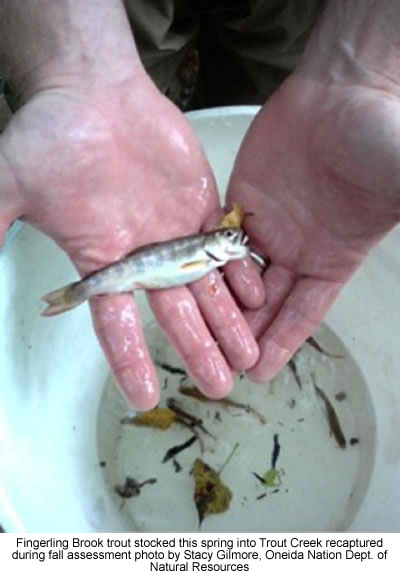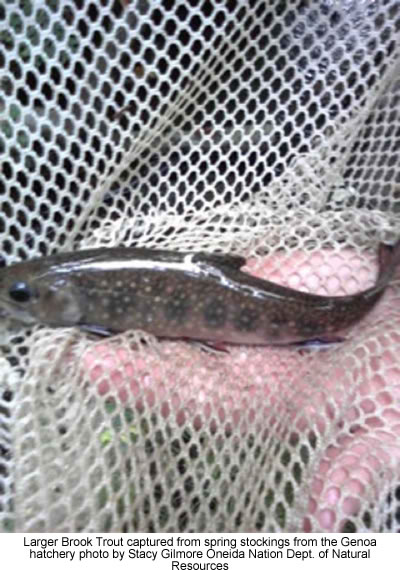 |
Canku Ota
|
 |
|
(Many Paths)
|
||
|
An Online Newsletter
Celebrating Native America
|
||
|
January 1, 2010 - Volume
8 Number 1
|
||
|
|
||
|
Partnerships Will
Help Save Our Natural Resources
|
||
|
by Ron "Tehassi"
Hill Jr. for the Green Bay (WI) Press Gazette
|
||
 The
Oneida Tribe of Indians has been a leader in restoration and sustainability
of our natural resources. The Oneida people know their responsibilities
to take care of Mother Earth are not negotiable. These are inherent
duties we have been given by our Creator, and they have been passed
down generationally. The
Oneida Tribe of Indians has been a leader in restoration and sustainability
of our natural resources. The Oneida people know their responsibilities
to take care of Mother Earth are not negotiable. These are inherent
duties we have been given by our Creator, and they have been passed
down generationally. In our ceremonies and in our philosophy, we teach our children to be mindful of how important it is to understand that the significance of our life begins and ends with our relationship with our environment. On our reservation, managing our resources in a cooperative manner begins with our intergovernmental relationships. Because the Oneida Reservation is enjoined with so many other governments, we have worked to build an atmosphere of open communication, shared resources and a vision for sustaining our environment for the next seven generations. Our ancient agricultural practices still provide the Oneida community with rich and fertile crops of our heirloom Oneida corn. This white corn has sustained Oneida people for centuries and the use of our corn to sustain ourselves was not limited to the nourishment of this precious food, but also how we used the entire plant. The stalks were used for fire, and weaving. The corn silks and husks were used for making dolls, braiding the corn for drying and also for weaving rugs and moccasins. The use of this natural resource is one example of how the Oneida people have utilized every resource in a manner that maximized every facet of that resource to nourish, protect and to sustain ourselves. As the Oneida Tribe established more recent environmental programs, we looked to create a division that would embrace, promote and implement our philosophy for our sustainability of the environment. We have one of the most successful and responsible environmental programs in the nation. The restoration work that has been done on our reservation over the past several decades is phenomenal. Last spring we were joined by Brown and Outagamie counties and the Wisconsin Department of Natural Resources in releasing more than 5,000 trout fingerlings into Trout Creek. For decades Trout Creek had been barren of any trout; it was time to restore these waters and this environment. Oneida is proud of this effort and the cooperation we experienced working with the local counties and the state. This is one of the success stories we are happy to share. This success gives the Oneida government the incentive to continue to move forward in building partnerships that provide a hope for the future generations to enjoy our natural resources. Officially, the mission of the Oneida Environmental, Health and Safety Division is to provide high quality services that protect and improve the health of the human and natural environment, consistent with Oneida's culture and vision. We strive to balance community, family and work. Ron "Tehassi" Hill Jr. is serving his first term on the Oneida Nation's nine-member Business Committee
Brook
Trout Alive and Well in Trout Creek
|
|
|
||
|
|
||
| Canku Ota is a free Newsletter celebrating Native America, its traditions and accomplishments . We do not provide subscriber or visitor names to anyone. Some articles presented in Canku Ota may contain copyright material. We have received appropriate permissions for republishing any articles. Material appearing here is distributed without profit or monetary gain to those who have expressed an interest. This is in accordance with Title 17 U.S.C. Section 107. | ||
|
Canku Ota is a copyright ©
2000, 2001, 2002, 2003, 2004, 2005, 2006, 2007, 2008, 2009, 2010
of Vicki Barry and Paul Barry.
|
||
 |
 |
|
|
The "Canku
Ota - A Newsletter Celebrating Native America" web site and
its design is the
|
||
|
Copyright ©
1999, 2000, 2001, 2002, 2003, 2004, 2005,
2006, 2007, 2008, 2009, 2010
of Paul C. Barry.
|
||
|
All Rights Reserved.
|
||
 Good
news coming from the fall fishery assessments on Trout Creek of
the Oneida Indian Reservation! Assessment results indicate good
growth and survival of the brook trout fingerlings stocked from
the Genoa National Fish Hatchery as 2.25 inch fingerlings this spring.
The fish have grown roughly .75 inches to 1.75 inches in length
this summer and this is very encouraging to see living proof that
the watershed is capable of sustaining brook trout again. The Trout
Creek watershed had many of its aquatic species reduced or eliminated
due to degrading water quality caused by inadequate manure storage
facilities in the upper watershed. Through action initiated by the
Oneida tribe and the Wisconsin Department of Natural Resources,
point source pollution was reduced and habitat rehabilitation efforts
were established. Brook trout were re-introduced according to the
Oneida Dept. of Natural Resources Trout Creek watershed management
plan, and the first of three year classes of brook trout were placed
in the Creek this spring. A strain of wild brook trout from Ash
Creek, Wisconsin was stocked to increase the chances that survival
would be high. Brook trout eggs were carefully screened for fish
pathogens by the LaCrosse (WI) Fish Health Center, and isolated
from other fish populations on the Genoa hatchery to reduce the
risk of disease. Human activity was also minimized during rearing
at the hatchery, to maintain startle responses of the fish and preserve
predator avoidance behavior after the fish were stocked. This cooperative
effort between the Green Bay National Fish and Wildlife Conservation
Office, the Genoa National Fish Hatchery, the Oneida tribe and the
Wisconsin Department of Natural Resources is a textbook example
of how conservation agencies can work together synergistically to
advance conservation efforts well into the future. Brook trout are
an excellent biological indicator of watershed health, and the presence
of live trout and the use of other watershed quality indices will
be used as tools to ensure that Trout Creek will have its namesake
as residents for generations to come.
Good
news coming from the fall fishery assessments on Trout Creek of
the Oneida Indian Reservation! Assessment results indicate good
growth and survival of the brook trout fingerlings stocked from
the Genoa National Fish Hatchery as 2.25 inch fingerlings this spring.
The fish have grown roughly .75 inches to 1.75 inches in length
this summer and this is very encouraging to see living proof that
the watershed is capable of sustaining brook trout again. The Trout
Creek watershed had many of its aquatic species reduced or eliminated
due to degrading water quality caused by inadequate manure storage
facilities in the upper watershed. Through action initiated by the
Oneida tribe and the Wisconsin Department of Natural Resources,
point source pollution was reduced and habitat rehabilitation efforts
were established. Brook trout were re-introduced according to the
Oneida Dept. of Natural Resources Trout Creek watershed management
plan, and the first of three year classes of brook trout were placed
in the Creek this spring. A strain of wild brook trout from Ash
Creek, Wisconsin was stocked to increase the chances that survival
would be high. Brook trout eggs were carefully screened for fish
pathogens by the LaCrosse (WI) Fish Health Center, and isolated
from other fish populations on the Genoa hatchery to reduce the
risk of disease. Human activity was also minimized during rearing
at the hatchery, to maintain startle responses of the fish and preserve
predator avoidance behavior after the fish were stocked. This cooperative
effort between the Green Bay National Fish and Wildlife Conservation
Office, the Genoa National Fish Hatchery, the Oneida tribe and the
Wisconsin Department of Natural Resources is a textbook example
of how conservation agencies can work together synergistically to
advance conservation efforts well into the future. Brook trout are
an excellent biological indicator of watershed health, and the presence
of live trout and the use of other watershed quality indices will
be used as tools to ensure that Trout Creek will have its namesake
as residents for generations to come.